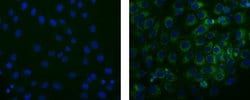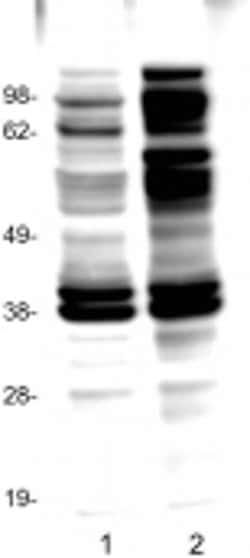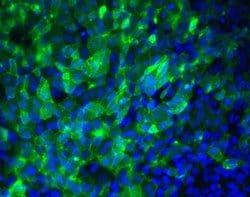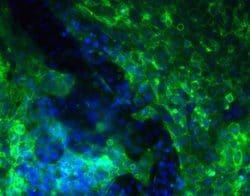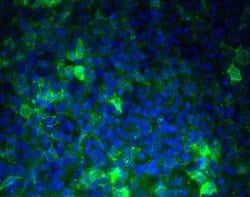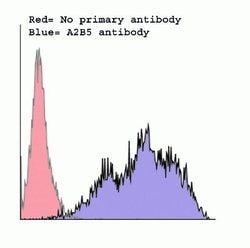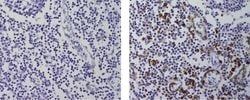50-112-2886
Cutaneous Lymphocyte Antigen (CLA) Monoclonal Antibody (HECA-452), eBioscience™, Invitrogen™
Manufacturer: Invitrogen
Select a Size
| Pack Size | SKU | Availability | Price |
|---|---|---|---|
| Each of 1 | 50-112-2886-Each-of-1 | In Stock | ₹ 13,172.00 |
50-112-2886 - Each of 1
In Stock
Quantity
1
Base Price: ₹ 13,172.00
GST (18%): ₹ 2,370.96
Total Price: ₹ 15,542.96
Antigen
Cutaneous Lymphocyte Antigen (CLA)
Classification
Monoclonal
Concentration
0.5 mg/mL
Formulation
PBS with 0.09% sodium azide; pH 7.2
Host Species
Rat
Quantity
100 μg
Primary or Secondary
Primary
Content And Storage
4° C
Form
Liquid
Applications
Flow Cytometry, Functional Assay, Immunohistochemistry (Paraffin), Western Blot
Clone
HECA-452
Conjugate
Unconjugated
Gene Alias
CLA
Purification Method
Affinity chromatography
Regulatory Status
RUO
Target Species
Human
Product Type
Antibody
Isotype
IgM κ
Description
- Description: This HECA-452 monoclonal antibody reacts with human Cutaneous Lymphocyte Antigen (CLA)
- This cell surface glycoprotein is most highly expressed on T cells in the skin
- Nevertheless, CLA can also be detected on some peripheral T and NK cells, as well as monocytes, neutrophils and CD1a+ dendritic cells
- Studies have determined that this antibody recognizes sialofucosylated glycans and sialyl Lewis x (sLex)
- CLA, which binds E-selectin and endothelial cell-leukocyte adhesion molecule 1 (ELAM-1), is involved in T lymphocyte infiltration and adhesion at cutaneous sites of inflammation
- The HECA-452 antibody has been reported to inhibit sLex binding to E-selectin; however, this property is still under debate in the literature
- Applications Reported: This HECA-452 antibody has been reported for use in flow cytometric analysis, western blotting, functional assays, and immunohistochemical staining of formalin-fixed paraffin embedded tissue sections
- Applications Tested: This HECA-452 antibody has been tested by flow cytometric analysis on human PBMCs and by immunohistochemistry on FFPE human tissue
- The HECA-452 antibody can be used at less than or equal to 0.125 μg/test for flow cytometry and at less than or equal to 10 μg/mL
- The antibody performs optimally with low pH antigen retrieval but high pH antigen retrieval can also be used
- It is recommended that the antibody be carefully titrated for optimal performance in the assay of interest
- This cell surface glycoprotein is most highly expressed on T cells in the skin
- Nevertheless, CLA can also be detected on some peripheral T and NK cells, as well as monocytes, neutrophils and CD1a+ dendritic cells
- Studies have determined that this antibody recognizes sialofucosylated glycans and sialyl Lewis x (sLex)
- CLA, which binds E-selectin and endothelial cell-leukocyte adhesion molecule 1 (ELAM-1), is involved in T lymphocyte infiltration and adhesion at cutaneous sites of inflammation.
Compare Similar Items
Show Difference
Antigen: Cutaneous Lymphocyte Antigen (CLA)
Classification: Monoclonal
Concentration: 0.5 mg/mL
Formulation: PBS with 0.09% sodium azide; pH 7.2
Host Species: Rat
Quantity: 100 μg
Primary or Secondary: Primary
Content And Storage: 4° C
Form: Liquid
Applications: Flow Cytometry, Functional Assay, Immunohistochemistry (Paraffin), Western Blot
Clone: HECA-452
Conjugate: Unconjugated
Gene Alias: CLA
Purification Method: Affinity chromatography
Regulatory Status: RUO
Target Species: Human
Product Type: Antibody
Isotype: IgM κ
Antigen:
Cutaneous Lymphocyte Antigen (CLA)
Classification:
Monoclonal
Concentration:
0.5 mg/mL
Formulation:
PBS with 0.09% sodium azide; pH 7.2
Host Species:
Rat
Quantity:
100 μg
Primary or Secondary:
Primary
Content And Storage:
4° C
Form:
Liquid
Applications:
Flow Cytometry, Functional Assay, Immunohistochemistry (Paraffin), Western Blot
Clone:
HECA-452
Conjugate:
Unconjugated
Gene Alias:
CLA
Purification Method:
Affinity chromatography
Regulatory Status:
RUO
Target Species:
Human
Product Type:
Antibody
Isotype:
IgM κ
Antigen: TCR alpha/beta
Classification: Monoclonal
Concentration: 0.5 mg/mL
Formulation: PBS with 0.09% sodium azide; pH 7.2
Host Species: Mouse
Quantity: 100 μg
Primary or Secondary: Primary
Content And Storage: 4° C
Form: Liquid
Applications: Flow Cytometry
Clone: IP26
Conjugate: Unconjugated
Gene Alias: FLJ22602; IMD7; LOC290071; MGC117436; MGC22624; MGC23964; MGC71411; RATTCB; RATTCBC1; RGD1359684; similar to RIKEN cDNA A430107P09 gene; T cell receptor beta locus; T3/TCR complex; TCB; TCBC1; t-cell antigen receptor; T-cell receptor alpha constant; T-cell receptor beta chain; T-cell receptor V alpha; tcr alpha; TCR alpha/ beta; TCR beta; TCRA; Tcrb; TRA; Tra29; TRAC; TRB; TRB@; TRCA
Purification Method: Affinity chromatography
Regulatory Status: RUO
Target Species: Human
Product Type: Antibody
Isotype: IgG1 κ
Antigen:
TCR alpha/beta
Classification:
Monoclonal
Concentration:
0.5 mg/mL
Formulation:
PBS with 0.09% sodium azide; pH 7.2
Host Species:
Mouse
Quantity:
100 μg
Primary or Secondary:
Primary
Content And Storage:
4° C
Form:
Liquid
Applications:
Flow Cytometry
Clone:
IP26
Conjugate:
Unconjugated
Gene Alias:
FLJ22602; IMD7; LOC290071; MGC117436; MGC22624; MGC23964; MGC71411; RATTCB; RATTCBC1; RGD1359684; similar to RIKEN cDNA A430107P09 gene; T cell receptor beta locus; T3/TCR complex; TCB; TCBC1; t-cell antigen receptor; T-cell receptor alpha constant; T-cell receptor beta chain; T-cell receptor V alpha; tcr alpha; TCR alpha/ beta; TCR beta; TCRA; Tcrb; TRA; Tra29; TRAC; TRB; TRB@; TRCA
Purification Method:
Affinity chromatography
Regulatory Status:
RUO
Target Species:
Human
Product Type:
Antibody
Isotype:
IgG1 κ
Antigen: CD3e
Classification: Monoclonal
Concentration: 0.2 mg/mL
Formulation: PBS with 0.09% sodium azide; pH 7.2
Host Species: Armenian Hamster
Quantity: 50 μg
Primary or Secondary: Primary
Content And Storage: 4° C, store in dark, DO NOT FREEZE!
Form: Liquid
Applications: Flow Cytometry
Clone: 145-2C11
Conjugate: PE-Cyanine5
Gene Alias: 4930549J05Rik; A430104F18Rik; AI504783; antigen CD3D, delta polypeptide (TiT3 complex); antigen CD3E, epsilon polypeptide (TiT3 complex); antigen CD3G, gamma polypeptide; antigen CD3Z, zeta polypeptide; AW552088; Cd247; CD247 antigen; CD247 antigen, zeta subunit; Cd247 molecule; CD3; CD3 antigen delta chain; CD3 antigen delta polypeptide; CD3 antigen gamma chain; CD3 antigen, delta polypeptide; CD3 antigen, delta subunit; CD3 antigen, epsilon polypeptide; CD3 antigen, gamma polypeptide; CD3 antigen, zeta polypeptide; CD3 delta; CD3 epsilon; CD3 epsilon chain; CD3 epsilon subunit; CD3 epsilon subunit precursor; CD3 gamma-chain; CD3 glycoprotein; CD3 glycoprotein precursor; CD3 molecule delta polypeptide; CD3 molecule, delta; CD3 molecule, epsilon; CD3 molecule, epsilon polypeptide; CD3 molecule, gamma; CD3 molecule, gamma polypeptide; CD3 protein; CD3 TCR complex; CD3 type I transmembrane glycoprotein; CD3 type I transmembrane glycoprotein precursor; CD3 zeta chain; Cd3d; CD3D antigen delta; CD3D antigen, delta polypeptide (TiT3 complex); CD3d molecule; CD3d molecule, delta (CD3-TCR complex); CD3-DELTA; Cd3e; CD3E antigen, epsilon polypeptide; CD3E antigen, epsilon polypeptide (TiT3 complex); CD3e molecule; CD3e molecule, epsilon (CD3-TCR complex); CD3epsilon; CD3-epsilon; Cd3-eta; Cd3g; CD3G antigen, gamma polypeptide; CD3g antigen, gamma polypeptide (TiT3 complex); CD3g molecule; CD3g molecule, epsilon (CD3-TCR complex); CD3g molecule, gamma (CD3-TCR complex); CD3-GAMMA; Cd3h; CD3Q; Cd3z; CD3Z antigen, zeta polypeptide (TiT3 complex); Cd3zeta; Cd3-zeta; CD3zeta chain; CD3-zeta/eta; Ctg3; Ctg-3; FLJ18683; IMD17; IMD18; IMD19; IMD25; Leu-4; OKT3, delta chain; T cell antigen receptor complex epsilon subunit of T3; T3/TCR complex; T3d; T3e; T3g; T3Z; T-cell antigen receptor complex, epsilon subunit of T3; T-cell antigen receptor complex, gamma subunit of T3; T-cell antigen receptor complex, zeta subunit of CD3; T-cell receptor CD3 epsilon chain; T-cell receptor CD3 epsilon subunit; T-cell receptor CD3 subunit zeta; T-cell receptor CD3, subunit zeta; T-cell receptor T3 delta chain; T-cell receptor T3 eta chain; T-cell receptor T3 gamma chain; T-cell receptor T3 zeta chain; T-cell receptor zeta chain; T-cell surface antigen T3/Leu-4 epsilon chain; T-cell surface glycoprotein CD3 delta chain; T-cell surface glycoprotein CD3 epsilon chain; T-cell surface glycoprotein CD3 gamma chain; T-cell surface glycoprotein CD3 zeta chain; T-cell surface protein; TcR CD3 delta-chain; TcR CD3 gamma-chain; TCR zeta chain; TCR zeta chain subunit; TCRE; Tcrk; TCRZ; TCRzeta; TiT3 complex; type I transmembrane protein; T-cell surface molecule CD3
Purification Method: Affinity chromatography
Regulatory Status: RUO
Target Species: Mouse
Product Type: Antibody
Isotype: IgG
Antigen:
CD3e
Classification:
Monoclonal
Concentration:
0.2 mg/mL
Formulation:
PBS with 0.09% sodium azide; pH 7.2
Host Species:
Armenian Hamster
Quantity:
50 μg
Primary or Secondary:
Primary
Content And Storage:
4° C, store in dark, DO NOT FREEZE!
Form:
Liquid
Applications:
Flow Cytometry
Clone:
145-2C11
Conjugate:
PE-Cyanine5
Gene Alias:
4930549J05Rik; A430104F18Rik; AI504783; antigen CD3D, delta polypeptide (TiT3 complex); antigen CD3E, epsilon polypeptide (TiT3 complex); antigen CD3G, gamma polypeptide; antigen CD3Z, zeta polypeptide; AW552088; Cd247; CD247 antigen; CD247 antigen, zeta subunit; Cd247 molecule; CD3; CD3 antigen delta chain; CD3 antigen delta polypeptide; CD3 antigen gamma chain; CD3 antigen, delta polypeptide; CD3 antigen, delta subunit; CD3 antigen, epsilon polypeptide; CD3 antigen, gamma polypeptide; CD3 antigen, zeta polypeptide; CD3 delta; CD3 epsilon; CD3 epsilon chain; CD3 epsilon subunit; CD3 epsilon subunit precursor; CD3 gamma-chain; CD3 glycoprotein; CD3 glycoprotein precursor; CD3 molecule delta polypeptide; CD3 molecule, delta; CD3 molecule, epsilon; CD3 molecule, epsilon polypeptide; CD3 molecule, gamma; CD3 molecule, gamma polypeptide; CD3 protein; CD3 TCR complex; CD3 type I transmembrane glycoprotein; CD3 type I transmembrane glycoprotein precursor; CD3 zeta chain; Cd3d; CD3D antigen delta; CD3D antigen, delta polypeptide (TiT3 complex); CD3d molecule; CD3d molecule, delta (CD3-TCR complex); CD3-DELTA; Cd3e; CD3E antigen, epsilon polypeptide; CD3E antigen, epsilon polypeptide (TiT3 complex); CD3e molecule; CD3e molecule, epsilon (CD3-TCR complex); CD3epsilon; CD3-epsilon; Cd3-eta; Cd3g; CD3G antigen, gamma polypeptide; CD3g antigen, gamma polypeptide (TiT3 complex); CD3g molecule; CD3g molecule, epsilon (CD3-TCR complex); CD3g molecule, gamma (CD3-TCR complex); CD3-GAMMA; Cd3h; CD3Q; Cd3z; CD3Z antigen, zeta polypeptide (TiT3 complex); Cd3zeta; Cd3-zeta; CD3zeta chain; CD3-zeta/eta; Ctg3; Ctg-3; FLJ18683; IMD17; IMD18; IMD19; IMD25; Leu-4; OKT3, delta chain; T cell antigen receptor complex epsilon subunit of T3; T3/TCR complex; T3d; T3e; T3g; T3Z; T-cell antigen receptor complex, epsilon subunit of T3; T-cell antigen receptor complex, gamma subunit of T3; T-cell antigen receptor complex, zeta subunit of CD3; T-cell receptor CD3 epsilon chain; T-cell receptor CD3 epsilon subunit; T-cell receptor CD3 subunit zeta; T-cell receptor CD3, subunit zeta; T-cell receptor T3 delta chain; T-cell receptor T3 eta chain; T-cell receptor T3 gamma chain; T-cell receptor T3 zeta chain; T-cell receptor zeta chain; T-cell surface antigen T3/Leu-4 epsilon chain; T-cell surface glycoprotein CD3 delta chain; T-cell surface glycoprotein CD3 epsilon chain; T-cell surface glycoprotein CD3 gamma chain; T-cell surface glycoprotein CD3 zeta chain; T-cell surface protein; TcR CD3 delta-chain; TcR CD3 gamma-chain; TCR zeta chain; TCR zeta chain subunit; TCRE; Tcrk; TCRZ; TCRzeta; TiT3 complex; type I transmembrane protein; T-cell surface molecule CD3
Purification Method:
Affinity chromatography
Regulatory Status:
RUO
Target Species:
Mouse
Product Type:
Antibody
Isotype:
IgG
Antigen: CD16
Classification: Monoclonal
Concentration: 5 μL/Test
Formulation: PBS with 0.2% BSA and 0.09% sodium azide; pH 7.2
Host Species: Mouse
Quantity: 100 Tests
Primary or Secondary: Primary
Content And Storage: 4° C, store in dark, DO NOT FREEZE!
Form: Liquid
Applications: Flow Cytometry
Clone: eBioCB16 (CB16)
Conjugate: PE-Cyanine5
Gene Alias: 4833442P21Rik; CD16; CD16-2; CD16A; CD16a antigen; CD16b; CD32; CD32 receptor 2; CDw32; cytolytic trigger molecule G7; Fc fragment of IgG intermediate affinity IV receptor; Fc fragment of IgG low affinity IIIa receptor; Fc fragment of IgG receptor IIIa; Fc fragment of IgG receptor IIIb; Fc fragment of IgG, low affinity III, receptor for (CD16); Fc fragment of IgG, low affinity IIIa, receptor; Fc fragment of IgG, low affinity IIIa, receptor (CD16a); Fc fragment of IgG, low affinity IIIa, receptor for (CD16); Fc fragment of IgG, low affinity IIIa, receptor for (CD16); Fc fragment of IgG, low affinity III, receptor for (CD16); Fc fragment of IgG, low affinity IIIb, receptor (CD16b); Fc gamma receptor III; Fc gamma receptor IIIa; Fc gamma receptor III-A; Fc gamma receptor IIIb; Fc gamma RIIIa; Fc gammaRIV; Fc receptor, IgG, low affinity III; Fc receptor, IgG, low affinity IV; Fc receptor-like 3; Fcg receptor III; FCG2; FCG3; Fc-gamma receptor III-2 (CD 16); Fc-gamma receptor IIIb (CD 16); Fc-gamma receptor IIIb (CD16); Fc-gamma RII-b; Fc-gamma RII-c; fc-gamma RIII; Fc-gamma RIIIa; Fc-gamma RIII-alpha; fc-gamma RIIIb; fc-gamma RIII-beta; Fc-gamma-RIIb; Fc-gamma-RIIc; FcgammaRIII; FcgammaRIII a.1; FcgammaRIII a.2; FcgammaRIII a.3; FcgammaRIIIA; FcgammaRIV; FCGR2; FCGR2A; FCGR2B; FCGR2C; FCGR3; Fcgr3a; FCGR3B; Fcgr4; FCGRIII; FcgRIV; FcR-10; FcRII-b; FcRII-c; FcRIII; FCRIIIA; FCRIIIb; Fcrl3; IGFR3; IgG Fc gamma receptor III; igG Fc receptor III; IgG Fc receptor III-1; igG Fc receptor III-2; IMD20; immunoglobulin G Fc receptor III; LOC100911825; Low affinity immunoglobulin gamma Fc region receptor III; low affinity immunoglobulin gamma Fc region receptor III-A; Low affinity immunoglobulin gamma Fc region receptor III-B; low affinity immunoglobulin gamma Fc region receptor III-like; Low affinity immunoglobulin gamma Fc region receptor IV; neutrophil-specific antigen NA; RP11-5K23.1; transmembrane receptor FcgammaRIII-X
Purification Method: Affinity chromatography
Regulatory Status: RUO
Target Species: Human
Product Type: Antibody
Isotype: IgG1 κ
Antigen:
CD16
Classification:
Monoclonal
Concentration:
5 μL/Test
Formulation:
PBS with 0.2% BSA and 0.09% sodium azide; pH 7.2
Host Species:
Mouse
Quantity:
100 Tests
Primary or Secondary:
Primary
Content And Storage:
4° C, store in dark, DO NOT FREEZE!
Form:
Liquid
Applications:
Flow Cytometry
Clone:
eBioCB16 (CB16)
Conjugate:
PE-Cyanine5
Gene Alias:
4833442P21Rik; CD16; CD16-2; CD16A; CD16a antigen; CD16b; CD32; CD32 receptor 2; CDw32; cytolytic trigger molecule G7; Fc fragment of IgG intermediate affinity IV receptor; Fc fragment of IgG low affinity IIIa receptor; Fc fragment of IgG receptor IIIa; Fc fragment of IgG receptor IIIb; Fc fragment of IgG, low affinity III, receptor for (CD16); Fc fragment of IgG, low affinity IIIa, receptor; Fc fragment of IgG, low affinity IIIa, receptor (CD16a); Fc fragment of IgG, low affinity IIIa, receptor for (CD16); Fc fragment of IgG, low affinity IIIa, receptor for (CD16); Fc fragment of IgG, low affinity III, receptor for (CD16); Fc fragment of IgG, low affinity IIIb, receptor (CD16b); Fc gamma receptor III; Fc gamma receptor IIIa; Fc gamma receptor III-A; Fc gamma receptor IIIb; Fc gamma RIIIa; Fc gammaRIV; Fc receptor, IgG, low affinity III; Fc receptor, IgG, low affinity IV; Fc receptor-like 3; Fcg receptor III; FCG2; FCG3; Fc-gamma receptor III-2 (CD 16); Fc-gamma receptor IIIb (CD 16); Fc-gamma receptor IIIb (CD16); Fc-gamma RII-b; Fc-gamma RII-c; fc-gamma RIII; Fc-gamma RIIIa; Fc-gamma RIII-alpha; fc-gamma RIIIb; fc-gamma RIII-beta; Fc-gamma-RIIb; Fc-gamma-RIIc; FcgammaRIII; FcgammaRIII a.1; FcgammaRIII a.2; FcgammaRIII a.3; FcgammaRIIIA; FcgammaRIV; FCGR2; FCGR2A; FCGR2B; FCGR2C; FCGR3; Fcgr3a; FCGR3B; Fcgr4; FCGRIII; FcgRIV; FcR-10; FcRII-b; FcRII-c; FcRIII; FCRIIIA; FCRIIIb; Fcrl3; IGFR3; IgG Fc gamma receptor III; igG Fc receptor III; IgG Fc receptor III-1; igG Fc receptor III-2; IMD20; immunoglobulin G Fc receptor III; LOC100911825; Low affinity immunoglobulin gamma Fc region receptor III; low affinity immunoglobulin gamma Fc region receptor III-A; Low affinity immunoglobulin gamma Fc region receptor III-B; low affinity immunoglobulin gamma Fc region receptor III-like; Low affinity immunoglobulin gamma Fc region receptor IV; neutrophil-specific antigen NA; RP11-5K23.1; transmembrane receptor FcgammaRIII-X
Purification Method:
Affinity chromatography
Regulatory Status:
RUO
Target Species:
Human
Product Type:
Antibody
Isotype:
IgG1 κ
